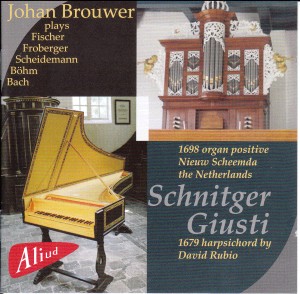|
|
World music CD DVD shop and Classic distribution
|
|
|
|
ID: ACDBO063-2 (EAN: 8717775550761) | 1 CD | DSD Released in: 2013
- LABEL:
- Aliud
- Collection:
- Baroque
- Composers:
- BÖHM, Georg | BACH, Johann Sebastian | FISCHER, Johann Caspar Ferdinand | FROBERGER, Johann Jacob | KOTTER, Johannes | SCHEIDEMANN, Johann Heinrich | SOLDT, Susanne van | VINJOR, N.
-
Interprets:
- BROUWER, Johan (organ)
- Other info:
There are a number of recordings of the choral partita ‘Ach wie nichtig, ach wie flüchtig’ by Georg Böhm (1666-1733), including one on the great Arp Schnitger city organ in Hamburg (1693), 57 voices, beautifully played by Stef Tuinstra. The version heard here is played on Arp Schnitger’s smallest organ positiv, 8 voices, but it offers enough variation to register the 8 variations in a diverse manner. The suite in A Minor ‘Melpomene’ by Johann Kaspar Ferdinand Fischer (1665-1746) is taken from his Musikalischer Parnassus (1738). Melpomene was the muse of song and tragedy. The stylised dances are a slow Allemande, the fast Passepied, a Rondeau, alternately a refrain and a verse, a Chaconne, variations based on a descending series of 4 tones and finally a fast Gigue. The Fantasia on the hexachord Vt Re Mi Fa Sol La by Johann Jakob Froberger (1616-1667) was already a famous work during his lifetime., Athenasius Kirchner mentions the work in his Masurgia (1646) and it was published in an autograph in 1649. The seven parts of the work bring the hexachord in various rhythms and with various second voices. In the sixth and seventh parts he adds chromatic tones, thus deftly exploiting the meantone temperament in the strong effect of dissonants and consonants. A true masterpiece. Johann Jakob Froberger (1616-1667) wrote the Tombeau on the death of the lute player Blancheroche in Paris and added the following remark: ‘fait à Paris sur la mort de Monsieur Blancheroche: lequel se joue fort lentement à la discretion sans observer aucune mesure.’ The improvisational character of the piece strongly resembles the Preludes non mésuree by Louis Couperin, whom Froberger met in Paris in 1652. A striking feature of this work is its exploitation of the meantone temperament, e.g. Froberger twice prescribes a D flat for where a C sharp is tuned, using the dissonant here as an expressive device. The Preludium is one of the great free forms in keyboard music. Of Hans Kotter (1485-1541) we hear an early example, here called Proömium in re. Kotter was a pupil of Paulus Hofhaymer, the most important ‘Organistenmacher’ of the 16th century, just as Sweelinck was in the 17th century. The original of the Giusti instrument is now in the Tagliavini collection in Bologna/Italy.
| BÖHM, Georg (1661-1733) | | | 1. | Ach wie nichtig, ach wie flüchtig | 10:37 | | | FISCHER, Johann Caspar Ferdinand (cca. 1670-1746) | | | 2. | Suite A-moll | 9:43 | | | FROBERGER, Johann Jacob (1616-1667) | | | 3. | Fantasia | 7:56 | | | 4. | Tombeau de Blancheroche | 5:45 | | | KOTTER, Johannes (1480 - 1541) | | | 5. | Prooemium in re | 1:32 | | | SCHEIDEMANN, Johann Heinrich (1595-1663) | | | 6. | Praeambulum | 4:22 | | | 7. | Galliarda ex D | 6:25 | | | SOLDT, Susanne van (ca. 1570-1599) | | | 8. | Wt de diepte o Heere, 130 sallem | 1:42 | | | LÜBECK, Vincent (1654-1740) | | | 9. | Praeludium and Fuge | 8:39 | | | BACH, Johann Sebastian (1685-1750) | | | 10. | Präludium in G-dur | 6:56 | |
|
|

